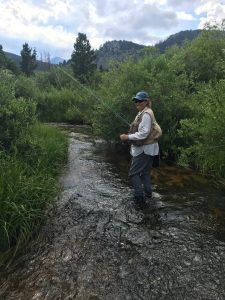Fishing blog: Tales of angling adventures from around the world
Welcome to our fish blog! Here you can read more sage advice from anglers around the world. This is the place for news, tips and non-fiction fish tales from mountain lakes to distant beaches. Please feel free to comment and join in on the conversations and share some fish tales of your own!
Yesterday, we decided to fish some of the lower streams in RMNP. The water levels have decreased as the snow melt eases up. Stay alert as afternoon rains in the high country can increase flows quickly. Although we had occasional sprinkles, serious rain held off and the streams we fished were wadable.
Starting below the fern lake trailhead, in the burn area, the Big Thompson River gave up several brook trout, and the population of brown trout is increasing. A few larger browns fell for either my favorite flying ant pattern or Kim’s parachute Adams. We should have tried grasshoppers since there were plenty of them in the meadows near the stream. We found an abundance of fingerlings in the shallows but, the deeper pools were where the larger browns were holding.
After catching and releasing plenty of fish there, we headed to the south side of Moraine Park and parked at the west end of S. Moraine Road. This area has been partitioned by exclusion fencing but you’ll find a gate into the protected area nearby. We fished inside the fenced area but found mostly smaller brook and brown trout there. We then hiked up South Lateral Moraine Trail a few hundred yards and found the best fishing of the day. German brown trout, though spooky, rose to our flies but required a stealthy approach and long casts upstream. An excess of algae and moss here made long floats impossible. We left when our mosquito repellent wore off resulting in a merciless attack by skeeters and deer flies. Before being forced to retreat, we caught and released some very respectable browns over 12”, which we considered a big fish for this small creek.
From there we moved up to Hollowell Park. In the past [60 years ago] Mill Creek had many productive beaver ponds where we caught brookies on every cast. The park service took out most of the ponds and the willows have taken over. Access to the creek was impossible due to the dense willows. We caught and released a few small brook and brown trout here but couldn’t get to any of the old ponds we hoped to find.
The next and final stop of the day was on Glacier Creek at the parking area created when the old Bear Lake Road was re-routed. We were the only folks fishing this spot, but the water looked promising. Long flat spots between rapids looked like good dry fly water. The water here had a dark hue to it that looked like suspended ash. It had a definite grey/black tint that discouraged feeding. To our surprise, we released a few rainbow trout that may have descended from Mill’s Lake.
We recommend a late afternoon trip for anglers that want to do some easy fly fishing in the park. We fished during the middle of the day with good results. Given enough bug repellent, the evening bite should be even better. Terrestrials are the best choice this time of year with emphasis on ants and grasshoppers. Stay stealthy and make accurate casts to the deeper pools for best results. Non-reserved entry into the Bear Lake Corridor begins at 6PM daily, which leaves two of the best hours of daylight to fish. Good Luck! Release these wild trout Alive!
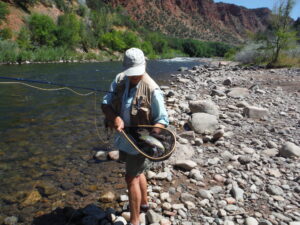 It’s been quite a while since most of us have fished dry flies so here’s a few ideas to improve your success with terrestrials this time of year. They’re bigger files than the tiny #20 midges that you see around your head while tying on another fly. Grasshoppers, beetles, ants, flying ants, all are considered terrestrial patterns that work in late summer. All show up easily with a parachute on top.
It’s been quite a while since most of us have fished dry flies so here’s a few ideas to improve your success with terrestrials this time of year. They’re bigger files than the tiny #20 midges that you see around your head while tying on another fly. Grasshoppers, beetles, ants, flying ants, all are considered terrestrial patterns that work in late summer. All show up easily with a parachute on top.
Before you get to the water, clean your fly line. It may look clean but that black stuff removed with your cleaning rag keeps it from floating high and dry. After this, and before it gets wet, put silicone on your fly. If you forgot this step and the fly is already wet, dry it off first. We keep a piece of a paper towel handy for this. Just squeeze the fly with the absorbent paper and then silicone it for a higher float. Make this standard procedure after each release. Then, put the left-over silicone left on your fingers on the area where the leader attaches to the fly line. This is the spot where most floating fly lines sink and pull the fly under water when you try to drag it across the surface.
Why does this matter? Well, most insects that fall into the water don’t go quietly to their demise. They flutter and kick trying to free themselves from the surface film. So, if you “twitch” the fly it helps it show up amongst the other inedible things floating by. We’re not talking about a long drag here, just an inch or two will suffice. Save the longer drags for the caddis patterns that entice strikes with that presentation.
Doing this little “skitter” straightens out the line and leader and helps you find the fly on the water. So, if your line isn’t floating, the fly will sink 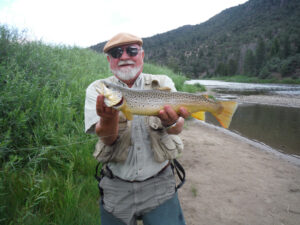 . A little movement assures the trout that this bug is real and freshly captured in the surface film. Try it, you’ll like it!
. A little movement assures the trout that this bug is real and freshly captured in the surface film. Try it, you’ll like it!
 This is a time of year dry fly enthusiasts look forward to. After watching strike indicators all winter and spring, its finally time to tie on something you can see and make them come up and eat it. Often, the strike on a terrestrial pattern will be enthusiastic; after surviving on tiny midges and nymphs for months, the opportunity to score a big meal is worth the effort.
This is a time of year dry fly enthusiasts look forward to. After watching strike indicators all winter and spring, its finally time to tie on something you can see and make them come up and eat it. Often, the strike on a terrestrial pattern will be enthusiastic; after surviving on tiny midges and nymphs for months, the opportunity to score a big meal is worth the effort.
Terrestrials include ants, grasshoppers, beetles, moths, bees, and other insects that spend their adult lives on land. From a fly angler’s perspective, they are larger and easier to see. The addition of a parachute or wing helps them show up even in marginal light conditions. Because most are tied on larger hooks, terrestrials are easier to tie onto a tippet in low light.
Just because you see a huge hatch of tiny flies, don’t think you need to “match the hatch”. Getting a trout to choose your fly amongst thousands of similar targets is often harder than getting them to try a 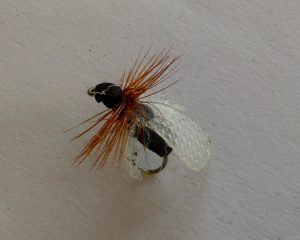 “real meal”.
“real meal”.
Evening hatches are always fun to fish but even during the middle of the day ants, grasshoppers and beetles are effective. This flying ant pattern has become a go-to favorite of ours.It floats well and has a plastic wing that’s easy to see. See more timely information at: http://www.anglerpocketguides.com/ – “Angler’s Guide to Rocky Mountain National Park”.
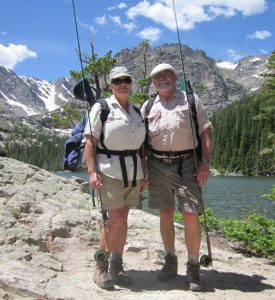 The 2.8-mile hike to The Loch [10,180 ft.] in Rocky Mountain National Park is easily worth the effort. Especially when you”re catching and releasing colorful hybrid cutthroat trout in crystal-clear mountain water. We recommend parking at the Bear Lake Parking area if you can arrive before 6AM. After that time, the lot will be full, and you should use the shuttle system. Before 6AM, park at the east end of the Bear Lake lot and use the horse trail shortcut down to the trailhead at Glacier Gorge. This means a little uphill at the end of the day but the downhill at the beginning makes for a good warmup. Of course, the current reservation system will also influence your starting time.
The 2.8-mile hike to The Loch [10,180 ft.] in Rocky Mountain National Park is easily worth the effort. Especially when you”re catching and releasing colorful hybrid cutthroat trout in crystal-clear mountain water. We recommend parking at the Bear Lake Parking area if you can arrive before 6AM. After that time, the lot will be full, and you should use the shuttle system. Before 6AM, park at the east end of the Bear Lake lot and use the horse trail shortcut down to the trailhead at Glacier Gorge. This means a little uphill at the end of the day but the downhill at the beginning makes for a good warmup. Of course, the current reservation system will also influence your starting time.
The trail climbs past Alberta Falls one half mile up the trail. Its’s a great photo opportunity and a place to catch your breath. Beyond the falls, “The Junction” is the next notable landmark. Trails from here lead to The Loch [including Lake of Glass and Sky Pond], to Mills Lake [including Black Lake, and to Lake Haiyaha [Including Dream Lake, Emerald Lake, Nymph Lake, and Bear Lake. The Loch lies .8 trail miles above this intersection.
Arriving at The Loch the trail continues along the north side of the lake with access to open areas of shoreline. Take advantage of rocky points and openings in the forested shoreline to put a fly on the water. Our favorite tactic here is to present a terrestrial fly pattern like an ant or beetle to cruising fish along the shoreline. The larger cutthroat trout here are quite territorial and will patrol a particular section of the shore. Your fly, presented in their territory, is usually accepted.
To access a less trampled area in the fall when Icy Brook is lower, cross near the inlet on any of the downed trees that form bridges. The area across the stream is a bog all summer but downstream towards the lake you’ll find meadows that make a good spot to cast with room for a back-cast. The shallows here call for stealthy casting and smaller flies than the spots across the lake. Put your fly about 10 feet ahead of a feeding fish once you see what direction they are heading.
Icy Brook itself holds cutthroats in the deeper runs and pools. Stand back from the bank when fishing this shallow, clear stream. The trout here are extremely wary and spook easily from shadows or movement. Back on the trail, it heads up Icy Brook alongside a significant waterfall where you’ll be scrambling, not hiking. Above the falls, the trail continues through dense willows to reach Lake of Glass and on to Sky Pond [10,900 ft.]. Icy Brook originates at Sky Pond which has brook trout and flows through Lake of Glass where cutthroats dominate before continuing through The Loch.
On a typical hike to the Loch we catch and release over 20 fish from 6” to 15” in length. They accept a variety of flies, but ant and beetle patterns are their favorites. Light 6X fluorocarbon tippet is helpful in these shallow, clear waters. Fly sizes in the 18-20 range are the most popular.
These are hybrid trout so a limit of two fish per adult angler may be kept. But…trying to get a trout down the trail on a hot afternoon in a warm backpack usually results in an inedible fish. We encourage release fishing in RMNP because these trout are wild populations and are never restocked. These beautiful hybrid cutthroat trout somehow survive and reproduce in this high-altitude environment, where their small population will be endangered by excessive harvest. Put them back for visiting anglers in the future to enjoy. Please practice catch and release with barbless flies in all RMNP waters
.
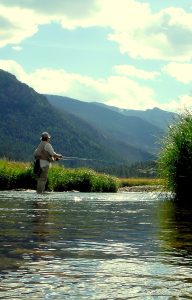 BEFORE the reservation system begins in Rocky Mountain National Park on May 27, and AFTER the snow melts but BEFORE the bulk of the spring runoff hits is a good time to fish Moraine Park. NOW is the time brook and brown trout begin to leave the deep pools where they survived the winter and they’re hungry. Emerger patterns and Adam’s dry flies will get their attention. Of course, the old reliable San Juan worm is still a favorite. If you’re mostly catching small fish, get stealthier.
BEFORE the reservation system begins in Rocky Mountain National Park on May 27, and AFTER the snow melts but BEFORE the bulk of the spring runoff hits is a good time to fish Moraine Park. NOW is the time brook and brown trout begin to leave the deep pools where they survived the winter and they’re hungry. Emerger patterns and Adam’s dry flies will get their attention. Of course, the old reliable San Juan worm is still a favorite. If you’re mostly catching small fish, get stealthier.



